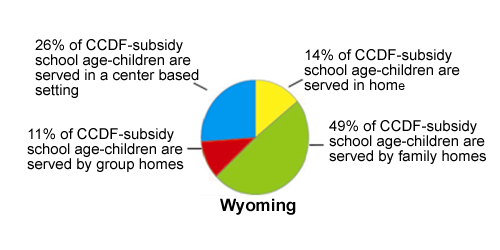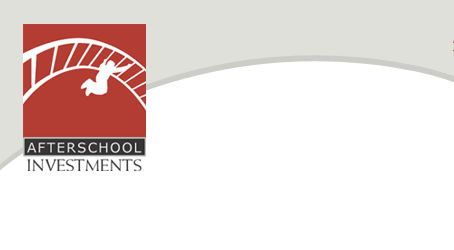|
The Afterschool Investments project has developed profiles for each state to provide a snapshot of the "state of afterschool," as well as an opportunity to compare afterschool activities across the country. This profile provides key data and descriptions of the afterschool landscape, which includes a range of out-of-school time programming that can occur before and after school, on weekends, and during summer months. It is designed to serve as a resource for policymakers, administrators, and providers.
Quick Facts
Demographics
| Total population: |
515,004 |
Number of children ages 5-12:
|
51,545 |
| Percent of population: |
10.0% |
Percent of students eligible for free and reduced-price lunch:
|
31.4% |
Percent of K-12 students in Title I "Schoolwide" schools:
|
17.2% |
For more demographic information, visit http://nccic.acf.hhs.gov/statedata/statepro/index.html
Child Care and Development Fund (CCDF)
• CCDF Administrative Overview
Administering agency: |
Wyoming Department of Family
Services |
Total FFY06 federal and state CCDF funds: |
$11,925,879 |
FFY06 total federal share: |
$8,195,992 |
FFY06 state MOE plus match: |
$3,729,887 |
FFY06 School Age & Resource and Referral Targeted Funds: |
$24,351 |
FFY06 Tribal CCDF Allocation:
|
$559,539 |
FFY05 Total Quality Expenditures: |
$2,296,157 |
Percent of children receiving CCDF subsidies who are ages
5-12: |
6.0% |
• Settings

Where CCDF-Subsidy school age-children are served:
| In a center based setting |
26% |
| By group homes |
11% |
| By family homes |
49% |
| In home |
14% |
• Uses of CCDF Targeted Funds and Quality Dollars for Afterschool
"Resource and referral and school-age" targeted funds:
The majority of this funding has been allocated for the expansion of Child Care Resource & Referral Services. Part of the expansion has included "Signature Series" training to providers across the state. This training is designed around children's books and incorporates activities the provider can use with the books. Each series has activities for all ages of children, including school age children. In this Plan period, the Department will be looking at school age specific materials that can be distributed to school age programs to increase the quality of care.
Other quality activities:
Data not available.
• Provider Reimbursement Rates
Label assigned by state for school-age rate category: |
6-12 years |
Maximum rate for center-based school-age category: |
$2.25/hour |
Notes: Rates are statewide. |
Standardized monthly center-based school-age rate: |
$180 |
Are separate subsidy rates offered for part-time and full-time care? |
Yes |
Temporary Assistance for Needy Families (TANF) and Child Care
FFY05 state TANF transfer to CCDF: |
$3,700,106 |
FFY05 TANF direct spending on child care:
|
$1,440,000 |
Program Licensing and Accreditation Policies
| Are there separate licensing standards governing the care of school-age children? |
No |
Are there specialized requirements for center-based care for school-age children? |
No |
Ratio of children to adults in school-age centers: |
5 years 12:1; 6 years and over 18:1 |
Number of National AfterSchool Association (NAA) accredited programs:
|
1 |
21st Century Community Learning Centers (21st CCLC)
FY06 state formula grant amount: |
$4,807,715 |
Most recent competition: |
January 2005 |
Applications funded: |
19 |
Total first year grant awards: |
$2,030,509 |
| Fiscal agent type: |
42.1% school district
57.9% other |
| Licensing required? |
No |
Return to top
Statewide Initiatives
-
21st Century State Incentive Grant. Wyoming leaders, through the state-level Wyoming Youth Development Collaborative, recently created a new grant program, the 21st Century State Incentive Grant (21st Century SIG), to encourage community collaboration around youth services in the state. Spearheaded by the Department of Education and the Department of Health, state officials combined four separate funding sources to implement the program: 21st Century Community Learning Centers; the Governor’s allocation of the Safe and Drug-Free Schools Program; a federal Substance Abuse and Mental Health Services Administration State Incentive Grant; and state tobacco settlement dollars. The funds will be used to achieve the following outcomes:
- Prevent alcohol, tobacco, and other drug use and abuse for youth ages 12–17;
- Reduce known risk factors and enhance known protective factors;
- Advance academic achievement through before- and afterschool activities, including during summer recess periods for youth of all ages; and
- Serve populations not normally served by the state educational agency, such as school dropouts and youth in detention centers.
The new grant program aligns the overlapping goals of the four funding streams and encourages communities to collaborate across systems to build a community-wide continuum of care during non-school hours. To date, 26 Wyoming communities have created community collaboratives and community advisory boards to oversee and coordinate this and other relevant funding sources at the local level.
For more information, see http://sad.state.wy.us/21SIG
-
FFY 2003 Afterschool Block Grants. Licensing rule changes in the state lowered the number of school-age children that family care providers could serve, yet demand for care remained. The state used its Child Care Development Fund quality dollars to start a block grant program to increase capacity for school-age care. Nine grants were awarded across the state, based on individual community needs. Grantees included community-based organizations, school districts, park and recreation services, and private day care facilities.
-
Governor’s Summit on Extra Learning Opportunities. Wyoming Governor Dave Freudenthal received an award from the National Governors Association for Best Practices, with funds from the C.S. Mott Foundation and the Wallace Foundation, to hold a statewide summit on extra learning opportunities (ELOs). In January 2004, Wyoming convened a range of state and local partners through the state’s videoconference technology to reach 26 sites. After hearing taped remarks from Governor Freudenthal and Superintendent of Public Instruction Trent Blankenship, community leaders had the opportunity to hear about state support for ELOs and collaboration and sustainability strategies for ELOs in communities. In follow-up, each group of community stakeholders devised community plans to support ELO development with state support.
Return to top
Notable Local Initiatives
-
Sweetwater Transit Authority Resources. The Sweetwater Transit Resources (STAR) addresses rural transportation challenges by providing dependable, efficient transportation services to children, adults, the elderly, and people with disabilities. STAR’s coordinated transportation system pools resources from many human-service agencies to deliver passengers from door to door at a rate they can afford. Children are able to travel safely without their parent(s) to child care centers, doctors’ appointments, and after-school activities. Child care centers, senior centers, nursing homes, the housing authority, and human service agencies contract with STAR to provide rides for their clients. The Federal Transportation Administration, the State of Wyoming, and several in-kind sources provide grant assistance. The majority of rides are subsidized through contracts with government and non-profit agencies.
Return to top
Statewide Organizations
National AfterSchool Association Affiliate:
Not Available
Statewide Child Care Resource & Referral Network:
Child Care Finder
P.O. Box 2455
Casper, WY 82602
Phone: 307-266-1236 or 800-578-4017
Fax: 307-266-4410
Email: casperccf@wyoming.com
Web: http://www.childrens-nutrition.com
STARS
2712 Thomes
Cheyenne, WY 82001
Phone: 1-800-400-3999 or 307-635-2272
Statewide Afterschool Network:
Wyoming Afterschool Alliance
626 Washington Street
Lander, WY 82520
Email:lbarton@fre1.k12.wy.us
Return to top
Additional Resources
State Child Care Administrators:
http://nccic.acf.hhs.gov/statedata/dirs/display.cfm?title=ccdf
State TANF Contacts:
http://www.acf.hhs.gov/programs/ofa/tanf-dir.htm
21st Century Community Learning Centers Contacts:
http://www.ed.gov/programs/21stcclc/contacts.html
Return to top
Notes and Sources
Demographics
Total population: Annual Estimates of the Population for the United States and States, and for Puerto Rico: April 1, 2000 to July 1, 2006, U.S. Census Bureau.
Number of children ages 5-12: Estimates of the Resident Population by Single-Year of Age and Sex for the United States and States: July 1, 2006, U.S. Census Bureau.
Percent of students eligible for free and reduced-price lunch rate: Numbers and Types of Public Elementary and Secondary Schools from the Common Core of Data: School Year 2005-06. U.S. Department of Education. Washington, DC: National Center for Education Statistics.
Percent of K-12 students in Title I "schoolwide" schools: Numbers and Types of Public Elementary and Secondary Schools from the Common Core of Data: School Year 2005-06. U.S. Department of Education. Washington, DC: National Center for Education Statistics. The federal Title I program provides funding to local school districts and schools with high percentages of poor children to help ensure that all children meet challenging state academic content and student academic achievement standards. Schools enrolling at least 40 percent of students from poor families are eligible to use Title I funds for schoolwide programs that serve all children in the school.
Child Care and Development Fund
The Child Care and Development Fund (CCDF) is the largest federal funding source for child care. States receive a funding allocation determined by formula and have broad flexibility to design programs that provide child care subsidies for low-income children under the age of 13 and to enhance the quality of child care for all children. Federal CCDF funding consists of mandatory, matching, and discretionary funds. Federal law requires that states spend at least 4 percent of their CCDF funds as well as additional targeted funds on activities to improve the quality and availability of child care. CCDF administrative data in this and the following sections is from the U.S. Department of Health & Human Services, Administration for Children and Families, Child Care Bureau, as reported by States, unless otherwise noted.
FFY06 state MOE plus match: In order to receive Federal matching funds, a state must expend Maintenance of Effort funds. Note that this does not capture actual expenditures, only the minimum required to draw down all available federal funds.
FFY06 Tribal CCDF Allocation: Federal CCDF Funds are awarded directly to Federally-recognized Indian Tribes.
FFY05 total quality expenditures: This data includes FY05 and prior year funds expended for quality from each of the CCDF funding streams (mandatory, matching, and discretionary) and expenditures under targeted funds for infant and toddler, school-age care and resource and referral. This figure provides information obtained from state financial reports submitted for FY05.
Uses of CCDF Targeted Funds and Quality Dollars for Afterschool: Portions of CCDF discretionary funds are targeted specifically for resource and referral and school-age child care activities as well as for quality expansion. (These funds are in addition to the required 4 percent minimum quality expenditure.)
Maximum rate for school-age category: Rate listed applies to center-based care; where rates vary by region or county, the rate for the most populated urban area is given.
Standardized monthly school-age rate: Monthly rate for a child, age 8, in care after school during the school year at a center in the most costly district for four hours per day, 20 days per month. Calculated (in the lowest tier of a tiered system) using information from the FY2006-2007. State CCDF Plan, including rate structures, as submitted to the U.S. Department of Health & Human Services, Administration for Children and Families.
Separate subsidy rates for part-time vs. full time and Tiered Reimbursement Rate Systems: U.S. Department of Health and Human Services. Child Care Bureau. Report of State Plans FY2006-2007.
Temporary Assistance for Needy Families (TANF) and Child Care
In addition to spending TANF funds directly on child care, a state may transfer up to 30 percent of its TANF grant to CCDF. Expenditures represent TANF funds spent in FY05 that were awarded in FY05 and prior years. Data from the U.S. Department of Health and Human Services, Administration for Children and Families.
Program Licensing and Accreditation Policies
States with separate school-age licensing standards and states with specialized requirements for child care centers serving school-age children: National Association for Regulatory Administration, 2005 Child Care Licensing Study, available at http://www.nara.affiniscape.com/displaycommon.cfm?an=1&subarticlenbr=104.
Ratio of children to adults in school-age setting: Data from the National Child Care Information Center (NCCIC), available at: http://nccic.acf.hhs.gov.
Number of NAA-accredited programs: Data from the National AfterSchool Association, March 2007, available at: http://www.naaweb.org.
21st Century Community Learning Centers
The No Child Left Behind Act of 2001 converted the 21st Century Community Learning Centers’ authority to a state formula grant. In past years, the U.S. Department of Education made competitive awards directly to school districts. Under the reauthorized law, funds flow to states based on their share of Title I, Part A funds. States use their allocations to make competitive awards to eligible entities. Data from the U.S. Department of Education 21st Century Community Learning Centers Office and the 21st CCLC Profile and Performance Information Collection System.
Return to top
The Child Care Bureau awarded a technical assistance contract to The Finance Project and their partner, the National Governors Association Center for Best Practices, for the Afterschool Investments project. The goals of the Afterschool Investments project include:
- Identifying ways that state and communities are using Child Care and Development Fund (CCDF) subsidy and quality dollars to support out-of-school time programs, and sharing these practices and approaches with other states;
- Identifying administrative and implementation issues related to CCDF investments in out-of-school time programs, and providing information and context (about barriers, problems, opportunities) as well as practical tools that will help CCDF administrators make decisions; and
- Identifying other major programs and sectors that are potential partners for CCDF in supporting out-of-school time programs and providing models, strategies, and tools for coordination with other programs and sectors.
Contact Us:
Email:
afterschool@financeproject.org
Web:
http://nccic.acf.hhs.gov/afterschool/
The Finance Project
1401 New York Avenue, NW
Suite 800
Washington, DC 20005
Phone: 202-587-1000
Web: www.financeproject.org
National Governors Association
Center for Best Practices
444 North Capitol Street, NW
Washington, DC 20001
Phone: 202-624-5300
Web: www.nga.org
The Afterschool Investments project’s State Profiles are designed to provide a comprehensive overview of noteworthy State and local initiatives across the country. Inclusion of an initiative in the Profiles does not represent an endorsement of a particular policy or practice.
|





